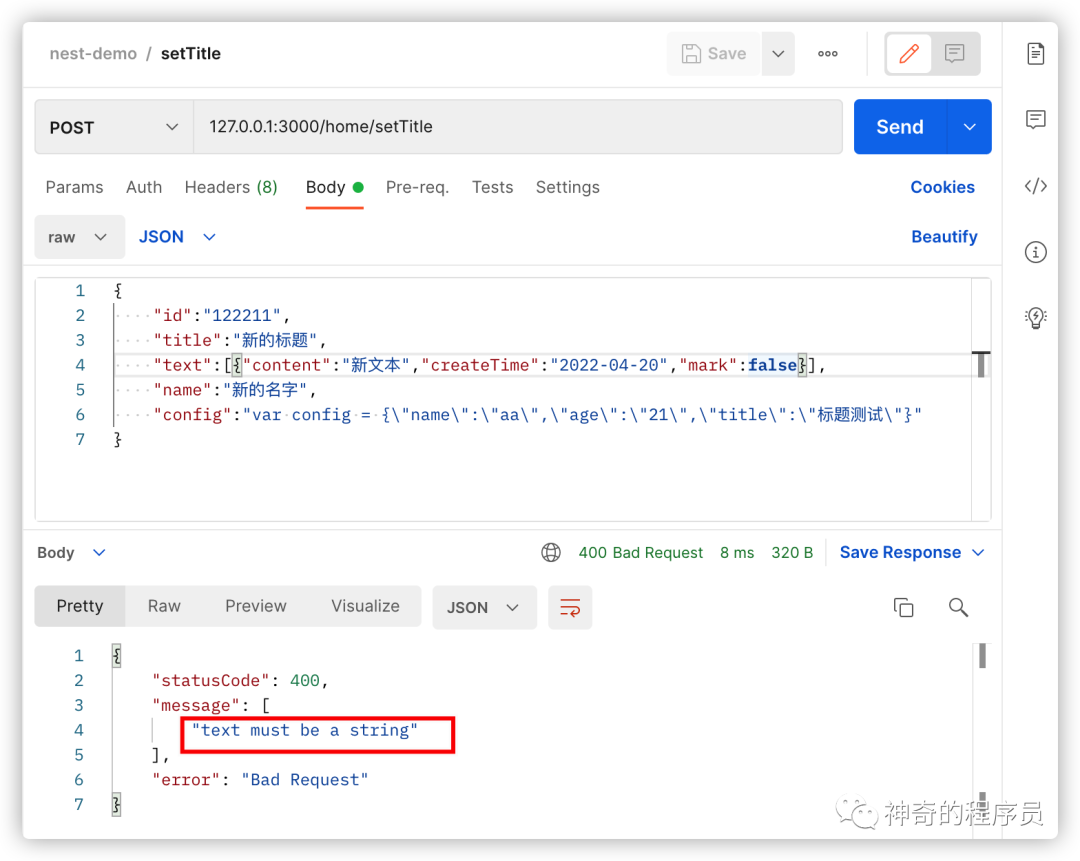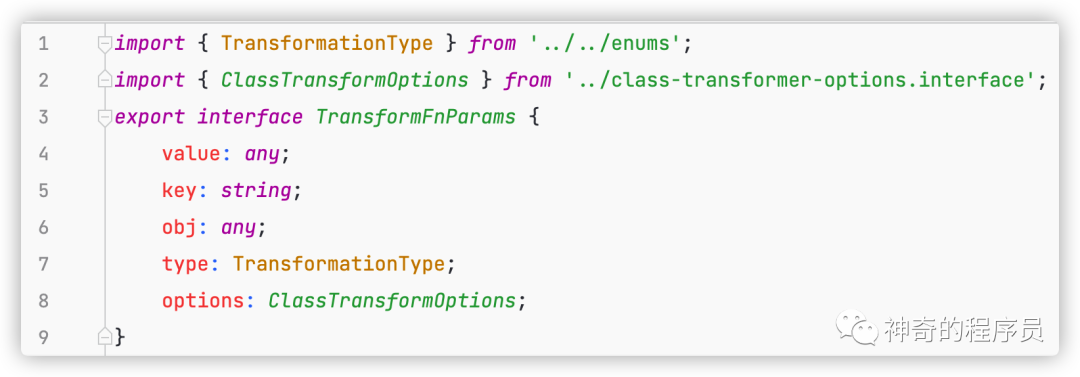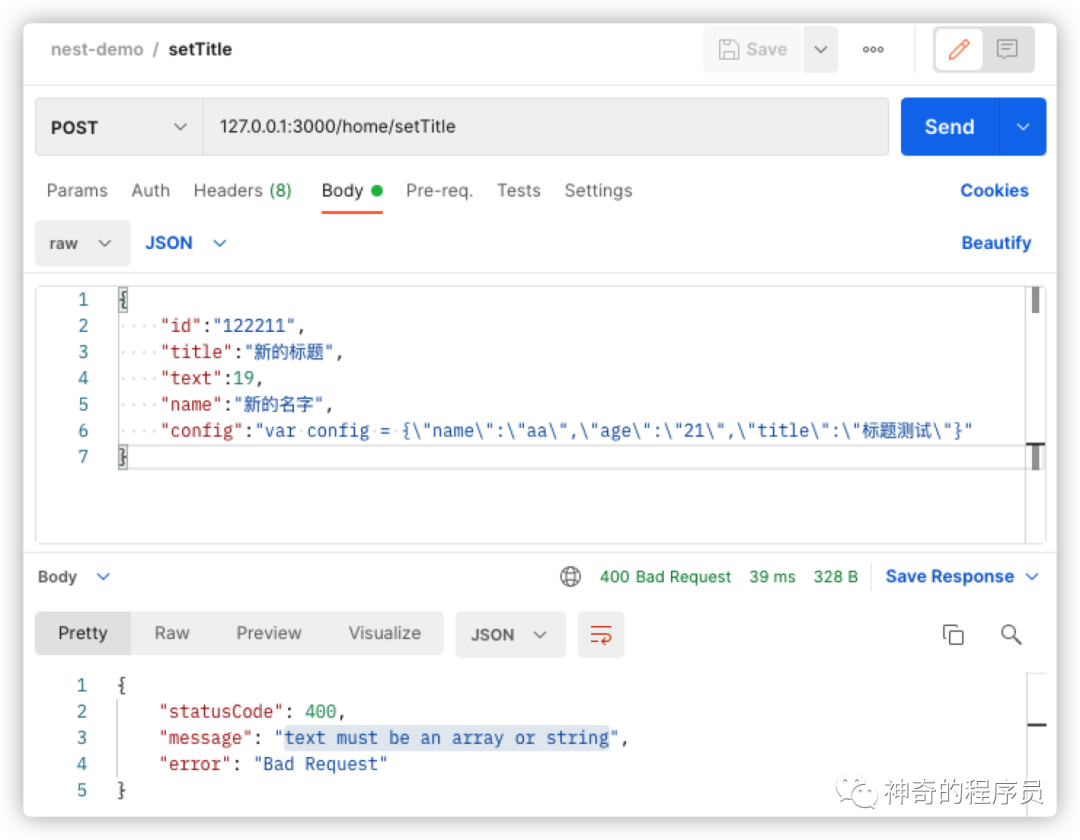场景概述
我们在进行接口开发时,客户端需要传入一个名为text的字段,它可能是string类型或Array<Object>类型(在TS中我们把这种关系称之为 联合类型 ),class-validator库中提供了相关的校验注解,那把他们写在一起能否完成相关的校验呢,如下所示:
export class AppDto {
@ApiProperty({ example: "2022年4月20日修改", description: "备注" })
@IsString()
@IsArray()
@ValidateNested({ each: true })
@Type(() => TextObjDto)
public text!: string | Array<TextObjType>;
}
TextObjDto的代码如下所示:
export class TextObjDto {
@ApiProperty({ example: "修复了一些bug", description: "内容" })
@IsString()
content!: string;
@ApiProperty({ example: "2022-04-20 07:52", description: "创建时间" })
@IsString()
createTime?: string;
@ApiProperty({ example: true, description: "是否为新功能标识" })
@IsBoolean()
mark?: boolean;
}
启动项目,用postman测试后发现并不好使,传了array类型的数据又要求是string类型,传了string类型的数据又要求是array类型。

注意:嵌套类型的对象验证需要使用@ValidateNested和@Type注解, @Type接受一个回调函数,函数内部需要返回一个用class声明的dto类。
解决方案
经过一番求助,翻了一圈class-validator的文档,发现没有现成的解决方案。那么,就只能自己拿到参数搞自定义校验了。
在class-transformer这个库中,提供了Transform方法,它接受一个回调函数作为参数,回调函数中提供了一个TransformFnParams类型的参数,其中的value字段就是客户端传过来的参数,我们只需要对其进行校验即可。

接下来,我们来看下实现代码,如下所示:
export class AppDto {
@ApiProperty({ example: "2022年4月20日修改", description: "备注" })
@IsOptional()
@Transform(({ value }) => checkTitleKey(value))
public text!: string | Array<TextObjType>;
}
上述代码中,我们有一个名为checkTitleKey的校验函数,因为需要自己校验,所以就需要自己把TS的类型校验复刻一遍出来,实现代码如下所示:
- 如果校验通过直接返回value参数即可
- 如果校验不通过直接使用nest内置异常进行抛出即可
export function checkTitleKey(
value: string | number | Array<TextObjType> | undefined | null
): any {
if (typeof value === "string") {
// 不做更改,直接返回
return value;
} else if (value instanceof Array) {
// 不能为空数组
if (value.length <= 0) {
throw new BadRequestException(
"property text cannot be an empty array",
"Bad Request"
);
}
for (let i = 0; i < value.length; i++) {
// 校验数组中的对象字段
const objKeys = Object.keys(value[i]);
if (objKeys.length <= 0) {
throw new BadRequestException(
"property text contains empty objects",
"Bad Request"
);
}
// 必须包含content字段
if (!objKeys.includes("content")) {
throw new BadRequestException(
"property text objects in the array must contain 'content'",
"Bad Request"
);
}
// 对每个key进行校验
for (let j = 0; j < objKeys.length; j++) {
switch (objKeys[j]) {
case "content":
// content字段必须为string类型
if (typeof value[i].content !== "string") {
throw new BadRequestException(
"property text 'content' of the objects in the array must be of type string",
"Bad Request"
);
}
break;
case "duration":
if (typeof value[i].createTime !== "string") {
throw new BadRequestException(
"property text 'createTime' of the objects in the array must be of type number",
"Bad Request"
);
}
break;
case "delay":
if (typeof value[i].mark !== "boolean") {
throw new BadRequestException(
"property text 'mark' of the objects in the array must be of type number",
"Bad Request"
);
}
break;
default:
break;
}
}
}
return value;
} else {
throw new BadRequestException(
"text must be an array or string",
"Bad Request"
);
}
}
TextObjType的声明也需要进行相对应的修改,如下所示:
- 全部变为可选参数,参数的必传与否已经在校验函数中处理了
- 类型全部变为any
export type TextObjType = {
content?: any;
createTime?: any;
mark?: any;
};
有一部分开发者可能比较迷惑,不是说ts用any是可耻行为吗,这我就要纠正下你了,既然它存在自然有使用场景。在我这个场景中,对象里所有key的类型校验都手动处理了,如果在此处定义了它的类型,在校验函数中就会报黄色警告,因此针对于需要手动校验类型的场景而言,使用any是最合适的。
结果校验
最后,我们针对于代码里定义的异常规则来验证下其是否能正常工作,如下所示:
# text字段为string类型
{
"id":"122211",
"title":"新的标题",
"text":"新替换的文本内容",
"name":"新的名字",
"config":"var config = {\"name\":\"aa\",\"age\":\"21\",\"title\":\"标题测试\"}"
}
>>> 接口调用成功
# text字段为Array类型所有key都存在
{
"id":"122211",
"title":"新的标题",
"text":[{"content":"新文本","createTime":"2022-04-20","mark":false}],
"name":"新的名字",
"config":"var config = {\"name\":\"aa\",\"age\":\"21\",\"title\":\"标题测试\"}"
}
>>> 接口调用成功
# text字段缺少content
{
"id":"122211",
"title":"新的标题",
"text":[{"createTime":"2022-04-20","mark":false}],
"name":"新的名字",
"config":"var config = {\"name\":\"aa\",\"age\":\"21\",\"title\":\"标题测试\"}"
}
>>> 接口报错400:property text objects in the array must contain 'content'
# text字段为number类型
{
"id":"122211",
"title":"新的标题",
"text":19,
"name":"新的名字",
"config":"var config = {\"name\":\"aa\",\"age\":\"21\",\"title\":\"标题测试\"}"
}
>>> 接口报错400:text must be an array or string
# text字段缺少createTime与mark
{
"id":"122211",
"title":"新的标题",
"text":[{"content":"新文本"}],
"name":"新的名字",
"config":"var config = {\"name\":\"aa\",\"age\":\"21\",\"title\":\"标题测试\"}"
}
>>> 接口调用成功
如下图所示,我们列举一个text字段为数字时的报错截图,运行结果符合预期,文章开头的问题成功解决:








































